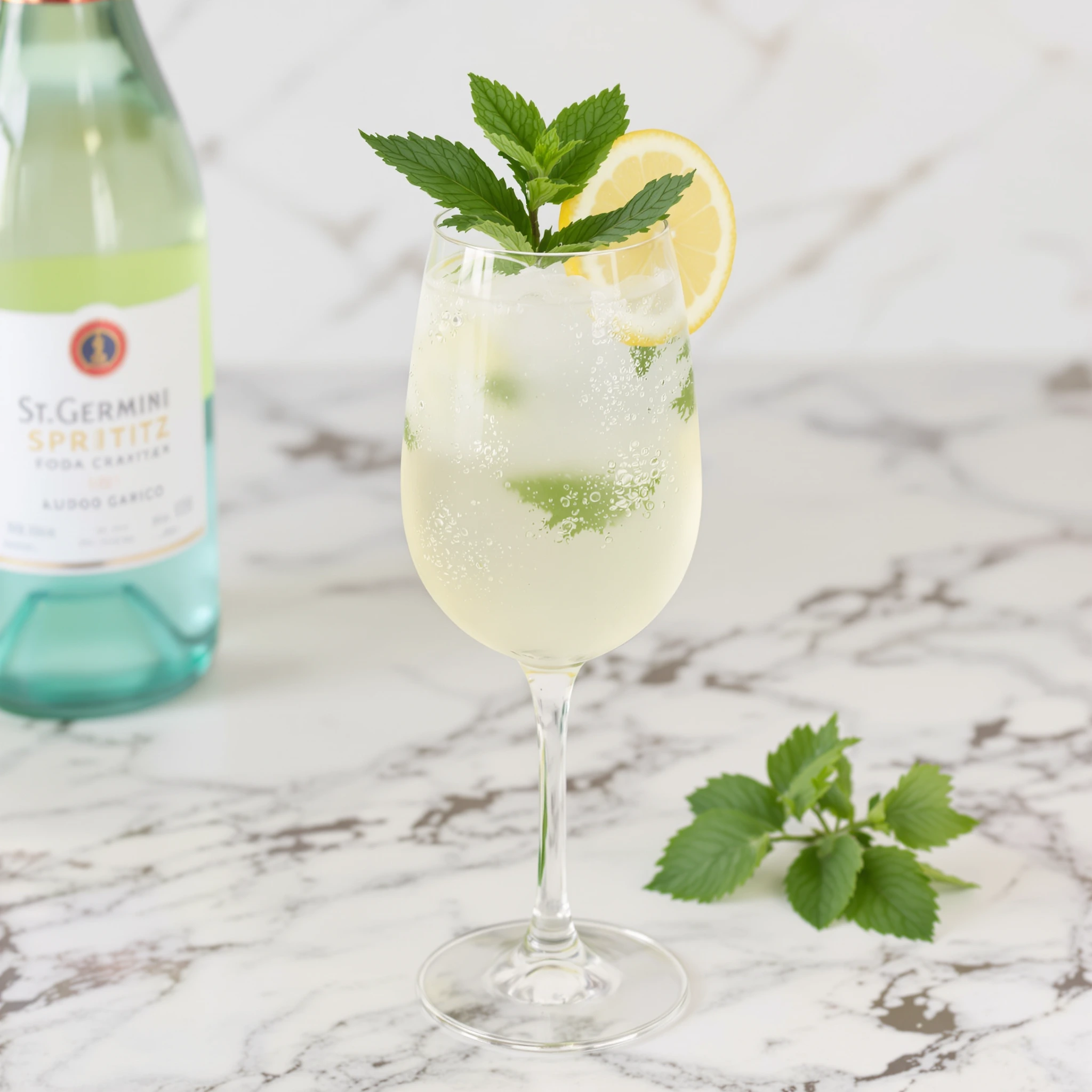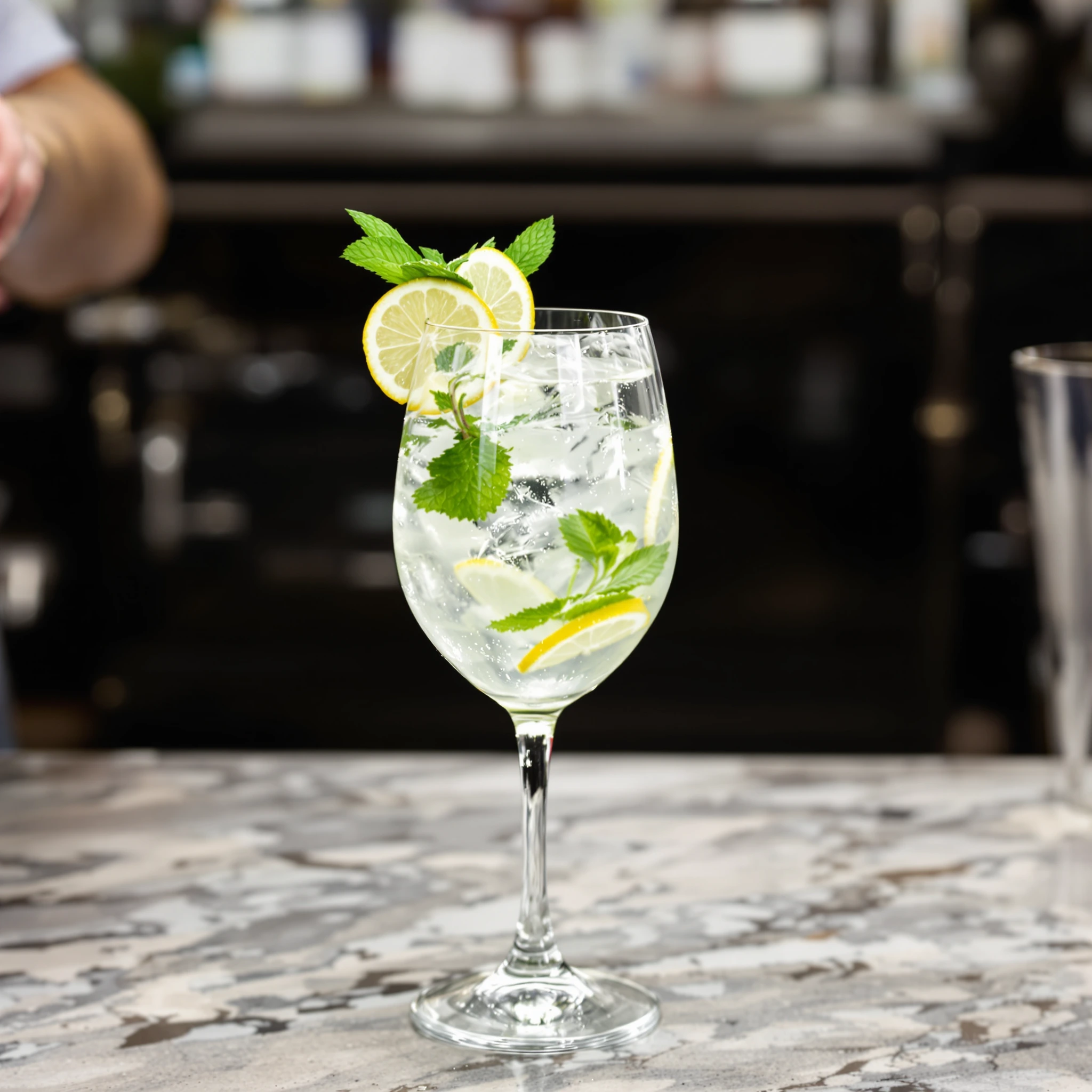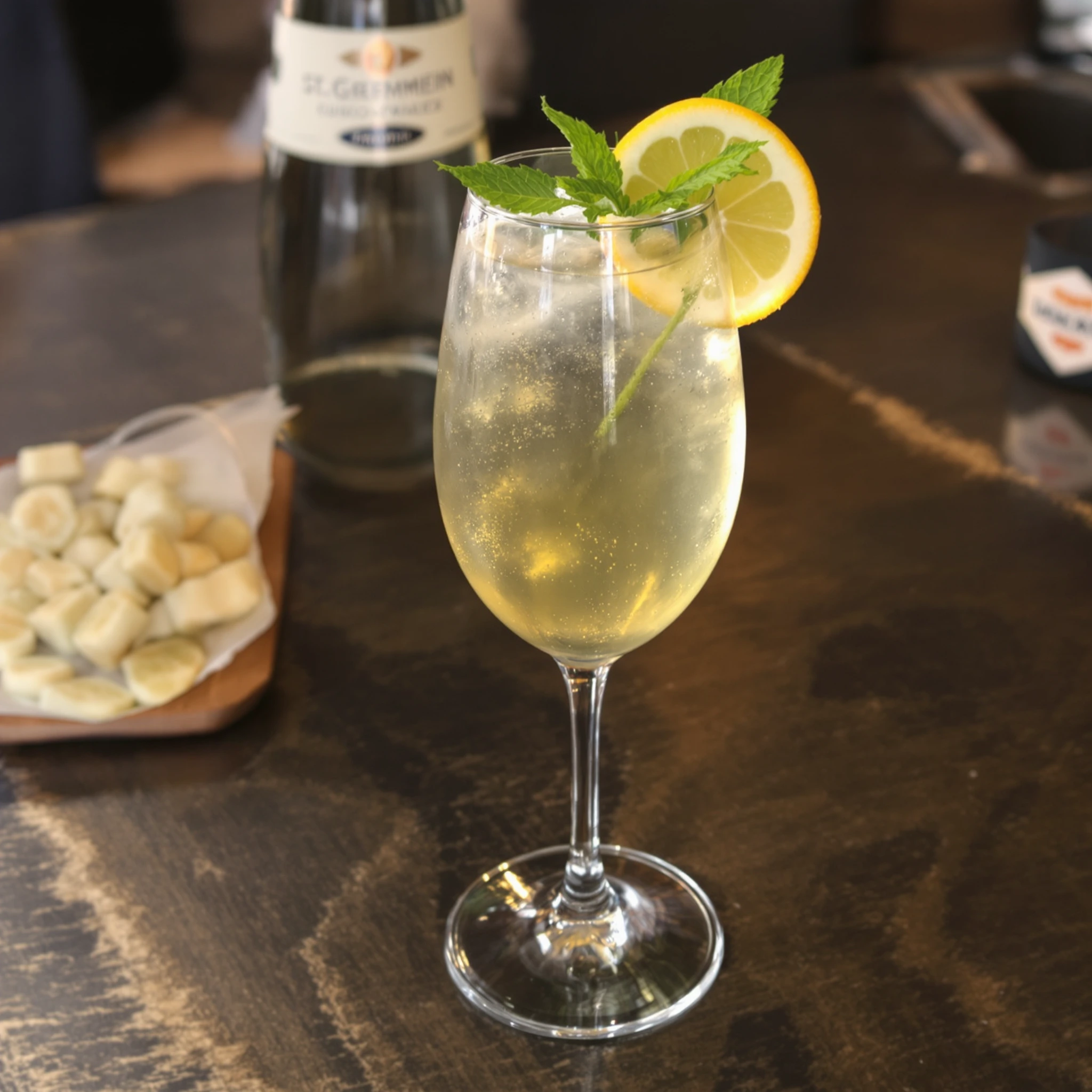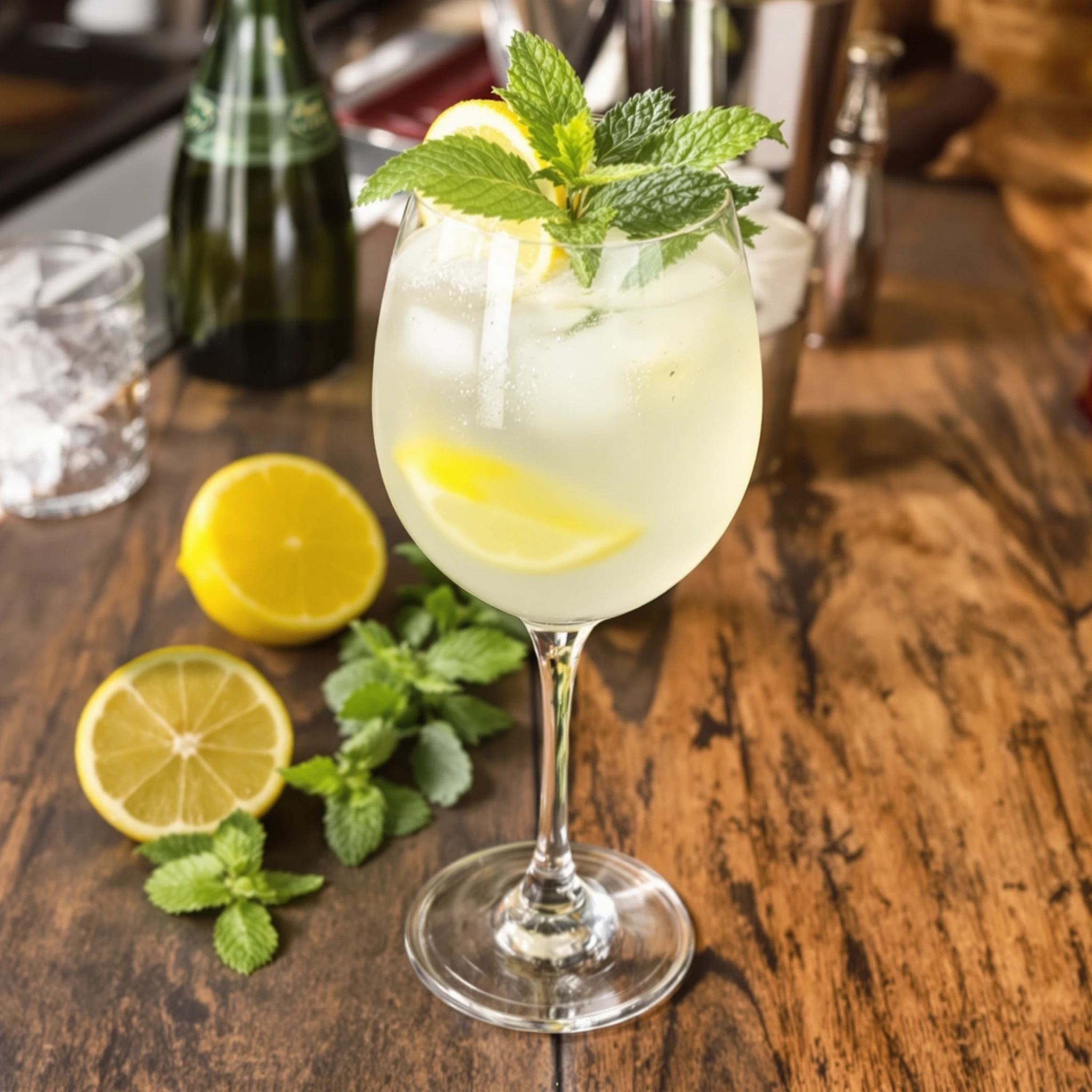Table of Contents
Brief Overview of the Hugo Spritz
The Hugo Spritz is a refreshing, light cocktail that has gained increasing popularity in recent years. Originating in Northern Italy, the drink was first created as a twist on the classic Italian spritz, which traditionally uses prosecco, soda, and bitters. The Hugo Spritz takes a more floral approach by incorporating elderflower syrup, which gives the cocktail a unique and fragrant sweetness, perfectly balanced by the effervescence of prosecco and sparkling water. Its bright and refreshing nature has made it a favorite for summer sipping, and its rise in popularity can be attributed to its light alcohol content and easy-drinking qualities.
Though it was first made popular in the South Tyrol region of Italy, the Hugo Spritz has quickly spread across Europe and to bars worldwide. It has become a staple in many cafes and restaurants during warm months due to its approachable flavor profile and aesthetic appeal. This cocktail combines the simplicity of a spritz with a hint of floral sweetness, making it a go-to choice for anyone looking to enjoy a relaxed but elegant drink.
The Appeal of the Hugo Spritz
The appeal of the Hugo Spritz lies in its well-balanced flavors and versatility. Its light and aromatic profile make it incredibly refreshing, especially when enjoyed on a warm day. The combination of bubbly prosecco, sweet elderflower syrup, and fresh mint leaves a pleasant, lingering taste that isn’t overpowering. Its natural sweetness from the elderflower and a hint of citrus from lime or lemon makes it the perfect cocktail for those who prefer something less bitter than a traditional spritz.
Compared to other popular cocktails, such as the Aperol Spritz or the Negroni, the Hugo Spritz is a lighter alternative with a more delicate flavor. It doesn’t rely on strong bitter notes but instead offers a smooth, aromatic experience. It’s also visually striking, with its pale golden color and vibrant green mint leaves, making it a fantastic addition to any gathering or celebration. The ease of preparation and the minimal ingredients involved have also contributed to its growing appeal.

Key Ingredients of a Hugo Spritz
Prosecco
What is Prosecco?
Prosecco is an Italian sparkling wine made primarily from the Glera grape variety. Originating from the Veneto and Friuli Venezia Giulia regions in northeastern Italy, prosecco is known for its light, crisp, and often slightly sweet flavor profile. Unlike Champagne, which undergoes a secondary fermentation in the bottle, prosecco is produced using the Charmat method, where the second fermentation happens in large tanks, giving it a fresher, fruitier taste.
Why Prosecco is Used in Hugo Spritz
In the Hugo Spritz, prosecco serves as the base of the drink, providing its signature effervescence and slightly dry, fruity taste. The addition of prosecco not only creates the refreshing sparkle in the drink but also balances the sweetness of the elderflower syrup. The light and crisp nature of prosecco perfectly complements the floral notes, making it the ideal partner for this cocktail.
Elderflower Syrup
Understanding Elderflower
Elderflower comes from the blossoms of the elderberry tree, which is native to Europe. Known for its delicate, floral aroma, elderflower is commonly used in beverages, syrups, and even culinary dishes. The flowers have a subtle sweetness and a flavor profile that combines hints of honey, citrus, and a light herbal note.
The Role of Elderflower Syrup
Elderflower syrup adds the signature floral sweetness to the Hugo Spritz. Its subtle, aromatic flavor enhances the overall drink, transforming it from a simple spritz into something unique and fragrant. The syrup is typically combined with sparkling prosecco and water, offering a refreshing sweetness that’s not overwhelming but just enough to balance the drink. Both homemade and store-bought elderflower syrups can be used, but the homemade version allows for a more tailored sweetness.
Sparkling Water
The Purpose of Sparkling Water
Sparkling water plays an essential role in the Hugo Spritz by adding an extra layer of effervescence to the drink. It helps dilute the sweetness of the elderflower syrup while ensuring the drink remains light and bubbly. The sparkling water also acts as a balancing agent, mellowing out the other ingredients and making the drink even more refreshing.
Recommendations for Best Brands
To achieve the best Hugo Spritz, opt for high-quality sparkling water. Brands like San Pellegrino or Perrier offer crisp, lightly carbonated water that won’t overpower the other flavors in the cocktail. Avoid overly strong carbonated waters, as they can detract from the drink’s delicate balance.
Fresh Mint
The Importance of Fresh Herbs
Fresh herbs, particularly mint, are crucial in the Hugo Spritz for both flavor and visual appeal. Mint adds a burst of freshness that complements the elderflower’s floral notes, providing a cooling effect that enhances the drink’s refreshment factor.
Other Herb Variations
While mint is the traditional herb used, you can also experiment with other herbs such as basil or rosemary. Each herb brings its own unique aroma and flavor, allowing for customization of your Hugo Spritz depending on your taste preferences or the occasion.
Lemon or Lime
Citrus in Cocktails
Citrus is often used in cocktails to add a burst of acidity that balances out the sweetness of other ingredients. In the case of the Hugo Spritz, lemon or lime juice brings a zesty touch that cuts through the sweetness of the elderflower syrup and adds a refreshing, tangy element to the drink.
Zest vs. Juice
For added depth, you can use both the zest and juice of your lemon or lime. The zest provides a subtle citrus aroma, while the juice adds a sharper, more distinct flavor. A combination of both is ideal for the perfect balance in your Hugo Spritz.

The Preparation Process
Step-by-Step Instructions
Gathering Ingredients
To make a Hugo Spritz, you’ll need:
- 3 ounces of Prosecco
- 1 ounce of elderflower syrup
- 1 ounce of sparkling water
- Fresh mint leaves
- A slice of lemon or lime (or zest)
- Ice cubes
Mixing the Drink
- Fill a glass with ice cubes.
- Pour in the elderflower syrup and sparkling water.
- Add the Prosecco, and gently stir to combine.
- Garnish with a sprig of fresh mint and a slice or zest of lemon or lime.
Serving Suggestions
Glassware
A Hugo Spritz is typically served in a wine glass or a large, wide tumbler to allow room for ice and garnishes. The large surface area helps the bubbles from the prosecco spread evenly.
Garnishing Techniques
For an extra touch, use a sprig of mint and a twist of lemon or lime zest as garnishes. You can also float a few extra mint leaves in the drink for added color and aroma.

Variations of the Hugo Spritz
Creative Twists on the Classic Recipe
Berry Hugo Spritz
Add a handful of muddled berries, such as raspberries or strawberries, to create a fruity, vibrant version of the Hugo Spritz. The berries infuse the drink with color and additional flavor while keeping it light and refreshing.
Tropical Hugo Spritz
For a tropical twist, try adding a splash of pineapple or mango juice. This variation brings a summery, exotic touch to the drink, making it perfect for warm weather gatherings.
Seasonal Variations
Winter Hugo Spritz
During the colder months, consider adding a touch of cinnamon or ginger to the syrup or using a spiced prosecco. This variation gives the drink a cozy, seasonal feel.
Festive Hugo Spritz
For holiday gatherings, a splash of cranberry juice or a cinnamon stick garnish can turn the Hugo Spritz into a festive drink for the season.
Pairing the Hugo Spritz with Food
Ideal Food Pairings
The light, aromatic nature of the Hugo Spritz makes it perfect for pairing with appetizers such as bruschetta, prosciutto, or cheese boards. It also complements light seafood dishes and fresh salads.
Dessert Pairings
Pair your Hugo Spritz with light desserts such as sorbet, fruit tarts, or lemon cakes to complement the citrus and floral flavors of the drink.
The Cultural Significance of the Hugo Spritz
Origin and Popularity
The Hugo Spritz was first created in the South Tyrol region of Italy, and it quickly gained popularity throughout the country. Its refreshing nature and unique flavor profile made it a summer favorite.
Global Influence
The Hugo Spritz has spread worldwide, inspiring variations in different countries and becoming a beloved choice in bars and restaurants.
Recap of the Hugo Spritz
The Hugo Spritz is a delightful, refreshing cocktail that combines prosecco, elderflower syrup, sparkling water, mint, and citrus for a unique and flavorful drink. Whether you enjoy the classic version or opt for a creative twist, this cocktail is sure to become a favorite.
Now that you know all about the Hugo Spritz, it’s time to try making one at home. Experiment with the ingredients and customize the drink to your liking. Share your creations with friends and family, and enjoy the beauty and flavor of this Italian classic!
FAQ SECTION
What is the Difference Between a Hugo Spritz and an Aperol Spritz?
The Hugo Spritz and the Aperol Spritz both fall under the category of spritz-style cocktails, which are known for being refreshing, light, and effervescent. However, the two drinks differ primarily in their base ingredients, flavor profiles, and historical origins.
Aperol Spritz
The Aperol Spritz is perhaps the more famous of the two, especially outside of Italy, and is recognized by its bright orange hue. This drink is made with three main ingredients:
- Prosecco: A sparkling wine from Italy that serves as the base for the cocktail, providing the effervescence and light, crisp character.
- Aperol: An Italian aperitif with a distinct orange flavor. It’s made from a blend of bitter oranges, herbs, and roots, with a slightly bitter and herbal taste that balances the sweetness of the prosecco.
- Soda Water: This ingredient dilutes the drink slightly while adding an extra touch of effervescence.
The Aperol Spritz has a bitter-sweet flavor profile, with the Aperol’s bitterness being the defining characteristic. It is bright and vibrant, with a low alcohol content (roughly 8% ABV) and a citrusy finish that makes it an excellent choice for summer.
Hugo Spritz
The Hugo Spritz, on the other hand, is a relatively newer addition to the spritz family but has quickly gained popularity, particularly in Northern Italy. Unlike the Aperol Spritz, which is known for its distinct bitterness, the Hugo Spritz is characterized by a light, floral, and sweet flavor. Its key ingredients include:
- Prosecco: Like the Aperol Spritz, the Hugo Spritz starts with prosecco, which adds the sparkling, crisp base for the drink.
- St-Germain: This is an elderflower liqueur that gives the Hugo Spritz its signature floral sweetness. It’s made from elderflower blossoms, which lend the cocktail its unique aroma and subtle, sweet taste.
- Sparkling Water: This helps to balance the sweetness of the elderflower liqueur and adds extra effervescence.
- Mint Leaves: Fresh mint adds a touch of herbaceous freshness that complements the floral and citrus notes of the drink.
- Citrus: Typically, a slice of lemon or lime is added to bring a zesty, citrusy element to the cocktail.
The Hugo Spritz is lighter, less bitter, and has a more delicate flavor profile compared to the Aperol Spritz. It’s often described as being crisp, refreshing, and fragrant. The floral notes of the elderflower liqueur are the key differentiating factor in the Hugo Spritz. In contrast, the Aperol Spritz has a more robust citrus and herb flavor.
In terms of alcohol content, the Hugo Spritz tends to have a lower alcohol concentration compared to the Aperol Spritz due to the use of elderflower liqueur, which has a lower alcohol percentage than Aperol. While Aperol has an ABV of around 11%, St-Germain has an ABV of 20% but is used in much smaller quantities, making the final alcohol content of a Hugo Spritz typically between 8-10% ABV.
How Much St-Germain is in Hugo Spritz?
St-Germain, the elderflower liqueur, plays a key role in the Hugo Spritz, lending the drink its signature floral sweetness. The exact amount of St-Germain used can vary depending on personal taste and the desired level of sweetness in the cocktail.
However, in a typical Hugo Spritz, the recipe calls for:
- 1 ounce (30 ml) of St-Germain
- 3 ounces (90 ml) of prosecco
- 1 ounce (30 ml) of sparkling water
This proportion creates a balanced cocktail where the St-Germain’s floral sweetness is noticeable but not overpowering. If you prefer a more robust elderflower flavor, you can adjust the amount of St-Germain to taste, adding a bit more to the mix. Conversely, if you enjoy a more subtle sweetness, you can reduce the St-Germain slightly.
The St-Germain liqueur itself is 20% alcohol by volume (ABV), so the small amount used in the Hugo Spritz contributes only a minor portion to the overall alcohol content. The primary alcohol in the drink comes from the prosecco, which has an ABV of about 11%.
How Much Alcohol is in Hugo Spritz?
The alcohol content in a Hugo Spritz depends on the specific proportions of ingredients used, but generally, the alcohol content of this cocktail falls between 8-10% ABV, making it a relatively light alcoholic beverage. The majority of the alcohol content comes from the prosecco, which is typically used in larger quantities compared to the elderflower liqueur.
Here’s a breakdown of the alcohol content in a standard Hugo Spritz:
- Prosecco (3 ounces, or 90 ml): Prosecco typically has an ABV of 11%. So, the amount of alcohol from the prosecco in the Hugo Spritz is about 0.33 ounces (9.9 ml) of alcohol.
- St-Germain (1 ounce, or 30 ml): St-Germain has an ABV of 20%, so the alcohol content from the elderflower liqueur is approximately 0.6 ounces (18 ml) of alcohol.
Thus, the total alcohol content in a Hugo Spritz made with the above measurements would be around 0.93 ounces (27.9 ml) of alcohol. When mixed with ice and diluted slightly by sparkling water, the overall alcohol concentration is typically between 8-10% ABV, which is similar to that of a light wine or a spritz.
If you prefer a more substantial alcoholic kick, you can always adjust the ratio of St-Germain or prosecco, but the beauty of the Hugo Spritz lies in its light, easy-to-drink nature.
Conclusion
In summary, the Hugo Spritz and the Aperol Spritz share similarities in terms of their effervescent base and refreshing qualities but differ significantly in flavor profiles. The Aperol Spritz leans toward bitterness, with the Aperol liqueur providing a strong, herbal kick, while the Hugo Spritz is much lighter, floral, and sweeter, thanks to the elderflower liqueur, St-Germain.
The amount of St-Germain used in a Hugo Spritz typically is 1 ounce (30 ml), which is enough to provide a delicate floral flavor without overpowering the drink. As for alcohol content, a typical Hugo Spritz will contain 8-10% ABV, making it a light and refreshing cocktail suitable for various occasions.
Whether you’re enjoying the crisp bitterness of an Aperol Spritz or the fragrant sweetness of a Hugo Spritz, both drinks offer a wonderful way to celebrate the simple pleasures of life, especially on a warm afternoon or at a lively gathering.

